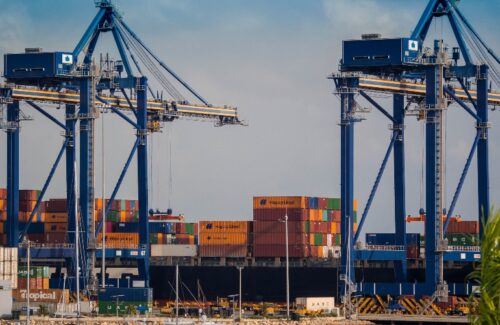There are many factors contributing to the widespread supply chain disruptions harming industries worldwide. Import tariffs and a global pandemic are at the heart of the issue. For the photovoltaic solar industry, there are also alleged human rights violations and additional trade regulations preventing the import of widely produced solar modules.

Credit: Kristina Gain
While the U.S. solar industry breaks installation records year after year, solar equipment manufacturers and suppliers are navigating a supply chain riddled with bottlenecks. Import tariffs on specific solar modules have increased the price of that vital component. Then, the alleged forced labor practices in Xinjiang province of China have prevented solar panels containing polysilicon harvested there from reaching U.S. soil. China is responsible for producing 80% of the world’s polysilicon, and half of that comes from Xinjiang.
In February 2018, the Trump Administration tariffed crystalline silicon cells and modules and AC/integrated modules by 30% with the intent to bolster domestic module manufacturing. That tariff is scheduled to sunset in 2022, its fourth year. But the International Trade Commission recommended another The tariffs have repeatedly changed for bifacial modules, with the most recent ruling exempting them again.
COVID-19 has posed an existential threat to the personnel responsible for maintaining the supply chain, and with the proliferation of another highly contagious strain of the virus, that squeeze on the supply chain remains indefinitely. During the 2020 COVID lockdowns, manufacturing ceased or was curbed and substantial shipments by sea were canceled. The shipping industry is still recovering.
“The supply chain has become less dependable,” said Jonathan Doochin, CEO of solar equipment distributor Soligent. “It has become less dependable, and sourcing products in a timely fashion with accuracy across a multitude of SKUs has required specific purchasers to understand the microeconomic factors in supply chain issues, in specific verticals and specific product lines. Though each one faces similar issues, each supply chain is a bit different with its own quirks.”
This supply chain chokehold comes at a time when federal legislators are attempting to pass the Build Back Better Act, an economic overhaul that includes incentives and goals that would greatly increase solar deployment in the country.
Increasing consumer demand in solar and federal renewable energy goals are putting a strain on other raw materials necessary for manufacturing accessory technologies for solar installations. Warehouses and distributors have had to increase purchases of solar equipment where possible, making it harder to source hardware.
“Availability matters. If somebody shorts on availability in this market, as a manufacturer it can change the outcome of the market share pretty substantially,” Doochin said.
While deliberation on the BBB Act continues, the U.S. solar industry pushes forward. SEIA and Wood Mackenzie reported in September that solar accounted for 56% of new electricity capacity installed in the first half of the year in the United States.
Despite a monumental need for deployment, many of the affected solar modules will remain in shipping yards. Manufacturers will try to find ways to meet that demand.
“The world is facing an inflationary cycle that, without price-fixing salaries, will inflate input cost,” Doochin said. “We’re in a secular inflationary cycle that reminds me of the 1970s.”





All of this is ignoring the fact that California and Florida are under siege as to the ability to net meter. If these two states lose their battle for net metering the rest of the country will be under siege as well. All of this talk about supply chains will indeed be mute as homeowners see that going solar doesn’t make any sense to install. My point is if you don’t have any demand, talking about supply chains isn’t worth talking about.
Tariffs have proven NOT to work; the excuse of the Pandemic Covid-19 is being pushed front and center as an often-offered excuse to supply chain problems. The industry has known for years if not decades where their materials for the manufacturing line are coming from. None have stepped up to remediate the flow of materials within this country’s borders. The manufacturing industry is laser focused on MOUs that ‘allow’ imported supply chain materials flow to affect their product line in the name of “economies of scale”. When these flagrant and dismissive boards of directors of these companies push internationalization. What they should be DOING now is use the alternative energy technology on their manufacturing lines and create multiple revenue streams as they chase the “economies of scope”, needed to take local raw materials and turn these into a refined supply chain for their own manufacturing as well as a revenue stream to other manufacturers needing materials. This willing ignorance has allowed the “supply chain” to become weaponized by those countries who by and large own the mining, refining and distribution for manufacturing materials to manufacturers Worldwide. The path ‘we’ are on is the same path this country followed into the arms of OPEC. DO ‘we’ really want to go through this again?